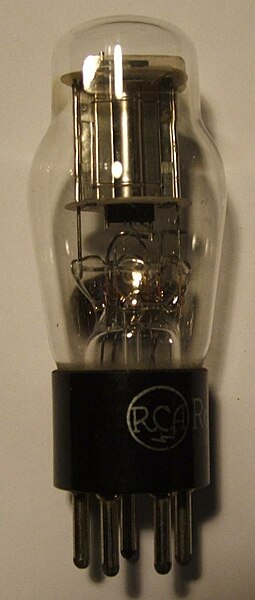A thyratron is a type of gas-filled tube used as a high-power electrical switch and controlled rectifier. Thyratrons can handle much greater currents than similar hard-vacuum tubes. Electron multiplication occurs when the gas becomes ionized, producing a phenomenon known as a Townsend discharge. Gases used include mercury vapor, xenon, neon, and hydrogen. Unlike a vacuum tube (valve), a thyratron cannot be used to amplify signals linearly.
Rare Z806W relay tube used in elevators
Wynn-Williams's scale-of-two counter using thyratrons (with permission of the Cavendish Laboratory, University of Cambridge, UK.)
R.C.A. brand 885 Triode Thyratron
A gas-filled tube, also commonly known as a discharge tube or formerly as a Plücker tube, is an arrangement of electrodes in a gas within an insulating, temperature-resistant envelope. Gas-filled tubes exploit phenomena related to electric discharge in gases, and operate by ionizing the gas with an applied voltage sufficient to cause electrical conduction by the underlying phenomena of the Townsend discharge. A gas-discharge lamp is an electric light using a gas-filled tube; these include fluorescent lamps, metal-halide lamps, sodium-vapor lamps, and neon lights. Specialized gas-filled tubes such as krytrons, thyratrons, and ignitrons are used as switching devices in electric devices.
A compact fluorescent bulb is a household application of a gas-filled tube
Noble gas discharge tubes; from left to right: helium, neon, argon, krypton, xenon
Other gases in discharge tubes; from left to right: hydrogen, deuterium, nitrogen, oxygen, mercury






